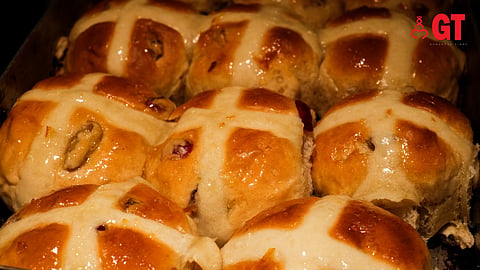

A symbol is an element that represents, or stands for, something else. Often unspoken and bigger than what meets the eye, whether it be shouted out from mountain tops or silently worn as a locket under a warm sweater, the importance of symbols has been felt, and seen, time and again.
While palm leaves were the symbols on Palm Sunday and have opened the doors to the week of the pain and suffering of Jesus Christ, the symbol that is highlighted on Maundy Thursday is a much tastier one – ever heard of hot cross buns?
GOAN SCENARIO
With our earliest recollection of hot cross buns being the nursery rhyme that went 'one a penny, two a penny, hot cross buns,' it’s about time we know about the real inspiration behind the catchy rhyme that lived in our heads, rent free.
In recent years, in Goa, it has become customary to distribute hot cross buns to churchgoers after the long Maundy Thursday service. Not forgetting how sometimes, these buns act as a warm, delicious incentive – especially to the ones who feel a little too lazy to go to church.
In fact, apart from the church, many Goan families also place their orders, in the various bakeries across Goa, to savour these hot cross buns. While these buns are commonly associated with Maundy Thursday, some Goans eat them even on Easter Sunday.
THEIR ORIGIN
Although hot cross buns may sometimes be considered mere loaves of bread, very few know that these spiced, sweet buns are symbolic and stand for more than just a ball of dough.
From pagans to Greeks to English monks, various theories surround the origin of hot cross buns. No one can be sure as to where this practice originated, although some say that parts of the hot cross buns have special relevance.
While the cross on the top represents the crucifixion of Jesus, the spices used while baking the buns signify the spices that were used to embalm Him once He was laid to rest. Additionally, they are also believed to be eaten in remembrance of the last supper that Jesus had with his disciples.
Parish priest of Our Lady of the Immaculate Conception Church, Panjim, Fr Walter De Sa, explains, “On Maundy Thursday, we follow an important rite of Jesus washing the feet of His disciples. During the holy mass, the priest, who symbolises Jesus, washes the feet of 12 lay people who have been chosen to represent Christ's disciples. Once the washing of the feet has been completed, we give each of them a bun with a cross on it, which is made of wheat.”
Over time, hot cross buns have been added to the list of Lenten food traditions of Goa. Even though the recipe of this confectionery changes from bakery to bakery, one thing which is certain is that if you happen to pass by a bakery in Goa during Holy Week, the aroma of these buns in the oven will be the best thing you have smelled all week!
He further adds, “This is a mere practice. Although it is not prescribed by the Church, we recreate it as a symbolic gesture of Jesus breaking bread and giving it to His disciples at the last supper."
Tales from South Goa shed light on how the custom of giving a hot cross buns for every person is quite a recent addition to Maundy Thursday. According to a traditional baker from the village of Nuvem, South Goa, only a few select people were given the privilege of participating in the Maundy Thursday service as disciples in the past.
The feet of these people were washed by the priest, after which, only their families were given a loaf of sweet bread with the marking of a cross on it.
Today, when it comes to attendance, be it a church full of people, or an entire empty pew, the hottest seat that is mandatorily occupied on Maundy Thursday is the one that a dozen hot cross buns are resting on.
DETAILS
PLACES YOU CAN PURCHASE: Padaria Prazeres, Breaking Bread with Aaron, Monginis, Pastry Cottage, Delfinos